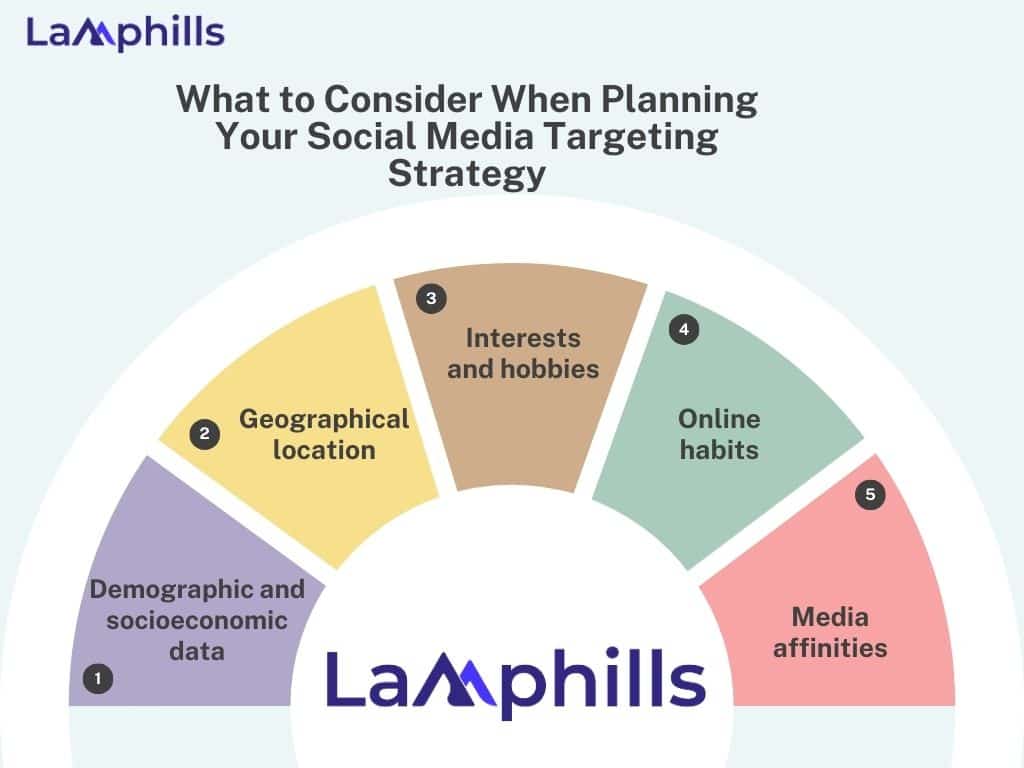Have you ever wondered how social media platforms seem to know exactly what interests you, almost as if they can read your mind? If you think about a new gadget, a vacation destination, or even a niche hobby, you start seeing ads and posts tailored to those interests. This phenomenon isn’t just a coincidence; it results from sophisticated social media targeting and audience targeting strategies businesses use to connect with potential customers.
I remember the first time I noticed this happening to me. I had been casually researching eco-friendly products, intrigued by a friend’s zero-waste lifestyle. Almost instantly, my social media feeds were flooded with ads for reusable straws, organic cotton bags, and sustainable fashion brands. It was both fascinating and slightly weird. How did they know? Let’s dive into the world of social media targeting and explore the intricacies of how our online behaviors are tracked, analyzed, and turned into tailored content.
Are you ready to uncover the secrets behind those accurate ads and posts?
Key Points
- Social media targeting is a marketing strategy where tailored content and ads are shown to specific groups of people to deliver relevant messages and increase engagement.
- Consider demographic data, geographical location, interests, online habits, and media affinities when planning your strategy. Questions like “Who am I trying to reach?” and “What makes this audience a good fit?” are essential to refine your approach.
- Critical strategies for social media marketing include consistent content creation, Adaptation to algorithm changes, Capitalization of viral moments, diversification of content across platforms, and enhancement of engagement through interaction.
- Define your target audience by understanding their needs, habits, and where they are active online. Use targeted advertising, work with influencers, and create relevant content to connect effectively.
- Analyze performance data regularly to refine your strategies. Use tools like Audience Insights to create personalized reports and targeting packs for strategic and effective social media campaigns.
What Is Social Media Targeting?

Credit: Freepik
Social media targeting is a marketing strategy where tailored content and ads are shown to specific groups of people. It’s an effective way to deliver relevant messages to different audience segments and increase engagement.
Platforms like Twitter, Facebook, and LinkedIn offer various targeting options to help you create custom audiences for your ads. These options are pretty advanced, but audience intelligence can make your targeting more precise and effective.
What to Consider When Planning Your Social Media Targeting Strategy
When planning your social media targeting campaigns, you can focus on several key areas:

- Demographic and socioeconomic data: gender, age group, job title, marital status
- Geographical location: city or country-level
- Interests and hobbies
- Online habits: social media platform usage
- Media affinities: T.V. shows, newspapers, radio, and magazines
Before deciding which of these areas to use or guessing which categories are most relevant to your audience, consider these questions:
- Who exactly am I trying to reach, and why?
- What makes this audience a good fit for my product/service?
- How can I tailor my messaging to capture their attention?
- How can I make my message resonate with them?
- How should I target my ads?
- Where should I geo-target my ads?
Answering these questions using audience intelligence tools like Audience Insights can help you build highly strategic and successful ad campaigns.
Mastering Social Media Targeting Strategies
I’ve created a mind map to help you craft your social media marketing strategy!
#1. Commit to Consistent Content Creation
Success in social media marketing hinges on regularly creating content. Consistency helps you figure out what your audience likes and what works best. For instance, a fashion brand might learn that behind-the-scenes videos get more engagement than regular promo posts. This insight helps in planning content that matches audience preferences.
Read: Top 11 Social Media Marketing Agencies for Small Businesses I Recommend in 2024
#2. Adapt to Algorithm Changes
Social media platforms often change their algorithms, shifting focus from follower counts to content quality. Brands need to adapt by making high-quality, engaging content. Analyzing successful posts to identify what works can help maintain visibility and engagement.
#3. Capitalize on Viral Moments
When content goes viral, it’s a golden opportunity to amplify your message. Repurpose viral content into ads or related posts to extend its reach. For example, if a funny promotional video for your tech firm goes viral, turning clips of that video into ads can boost engagement and conversions.
#4. Diversify Content Across Platforms
Different platforms cater to various audiences and content styles. LinkedIn works well for B2B marketing, while TikTok appeals to younger users with short, entertaining content. Tailoring your approach for each platform ensures your content is compelling and engaging.
#5. Enhance Engagement Through Interaction Engagement
It isn’t just about posting content and interacting with your audience. Responding to comments and asking for feedback makes your brand more relatable and approachable. This practice builds a loyal community and provides insights into audience preferences for future content.
#6. Value Authenticity
Consumers can easily spot inauthenticity. Authentic content that reflects your brand’s actual values resonates more with audiences. Share real stories, show the people behind your brand, and maintain a genuine voice in all communications.
#7. Master Strategic Posting
Knowing the best times to post and the types of content that perform well can boost your social media impact. Tools like Buffer or Hootsuite provide analytics to determine when your audience is most active, optimizing your posts for more visibility.
#8. Utilize Data Analytics:
Regularly analyzing performance data is crucial. It helps refine your strategies and better target your content. For example, if data shows that videos perform twice as well as photos on your Facebook page, shift more resources toward video production.
#9. Invest in Emerging Platforms
Exploring new platforms can be very rewarding. Early adoption of platforms like TikTok has benefitted brands that capitalized on its growth. Investing in emerging platforms allows you to capture attention in less competitive spaces and build a solid presence as the platform grows.
#10. Network and Collaborate
Collaborations can significantly expand your reach. Partnering with influencers or other brands can introduce your content to a broader audience. For example, a coffee shop might collaborate with a famous bakery, creating co-branded content that appeals to both customer bases.
How to Reach Your Target Audience
Ready to reach your target audience? Here are some steps to get started:
#1. Define Your Target Audience
First, you need to know who you’re targeting. Define your target audience by:
- Understanding your products and who might benefit from them
- Looking at your existing customers and doing audience research
- Going beyond demographics to explore psychographic data
- Creating core target audience segments
- Checking out your competitors and their customer base
Knowing your target audience will guide every part of your marketing strategy.
#2. Learn Where Your Audience Is Active
Once you identify your target audience, determine where they hang out online. Are they on Instagram? Do they prefer trade publications over corporate blogs? Knowing where they are most active will help you deliver your message on the right platforms.
Read: 7 Unbelievable Audience Behavior Hacks That Will Skyrocket Your Conversions Overnight
#3. Create Relevant Content
Your content is your message to your target audience. Understand their needs and struggles, and create content that addresses them. This could be blog posts, emails, social media content, ads, videos, or other formats. Use data to create more content that your target audience loves.
#4. Use Targeted Advertising
“Create and they will come” isn’t always true, especially for new brands. Use targeted ad campaigns on the platforms your audience uses. Google ads and social media ads offer advanced targeting capabilities. You can target based on age, location, interests, life stage, job role, and income to ensure your ads reach people likely to be interested in your brand.
#5. Work with Influencers
Influencer marketing involves working with people who have built a reputation in a specific niche. Influencers can create content, promote your brand, and help you make more sales. Team up with influencers whose audiences are the people you want to reach, and use their pre-built trust to drive their followers to your website and platforms.
#6. Create a Referral Program
Referral programs encourage existing customers to recommend your products to friends and family. Recommendations from people they trust are highly credible. Offer incentives like cash back, discounts, or free products to foster closer relationships with your existing customers.
#7. Use hashtags on social media
Using hashtags on platforms like Instagram and TikTok can extend your reach and engage your target audience. Find trending hashtags in your niche and incorporate them into your posts. This will help you appear in the feeds of people searching for those hashtags.
#8. Stay in Touch with Your Audience
Once you reach your target customers, don’t leave them hanging. Stay in touch by encouraging them to sign up for your email list, sending regular, relevant emails, and continuing to connect with them on their favorite social media platforms.
Download a comprehensive Target Audience Identification Checklist checklist to guide you in reaching your desired audience.
Who Does Social Media Target the Most?
Millennials are the most active group on social media, with about 68.8% expected to be using it in 2024. However, when it comes to daily time spent, Gen Z takes the lead, with 35% spending more than two hours a day on social media.
Source: McKinsey
What Social Media Gets the Most Views?
Facebook is still the most popular social media platform for consumers and marketers. It recently hit 3 billion monthly active users, making it the first social media platform to reach this milestone.
While the time spent on Facebook has increased slightly from the previous year’s 30 minutes per day, more than a 9-second increase is needed to say people spend much more time on it daily.
Younger users are still more drawn to TikTok and Snapchat. Among 13-17-year-olds, only 4.8% use Facebook, indicating it’s not the best platform for targeting a younger audience.
Source: Statista
Social Media Audience Targeting
A social media target audience will most likely be interested in your product or service. These people usually share common traits. A brand can have several target audiences, each segmented based on shared characteristics.
Let’s look at some examples to understand this better.
Take Canva, the design tool. Their audience includes designers and design enthusiasts, which their tool use can further segment.
For instance, one of Canva’s target audiences is teachers who use the tool to create worksheets, infographics, or posters.
Another key target audience for Canva is social media professionals. They typically use Canva to create eye-catching visuals for their brand’s social media and digital campaigns.
Social Media Targeting Process with Audience Insights
#1. Creating Your Personalized Audience Insights Report
First, you’ll name your report and define your Audience using these options:
- Profile attributes: Gain insights based on biography keywords, gender, job title, account followers, and more.
- Conversations: Find audiences based on hashtags, keywords, or URLs they’ve used.
- Uploading your Audience: Identify an audience by uploading a file with profile handles.
Choose the option that best aligns with your goals and click “Launch.” Your report can be ready in minutes, depending on the complexity of your audience definition.
#2. Understanding Key Features of Your Report
One of the most valuable sections for social media targeting is Segments. This section shows who your Audience is and lets you drill down into each segment to uncover demographic data, media affinities, social media usage, and online habits.
#3. Download Targeting Packs for Your Key Segments
Audience Targeting Packs suggest who to target per channel based on your Audience’s affinities. Here’s how you can use each section of the pack:
- Cities: Useful for geotargeting campaigns. Copy the list of relevant cities into your ads manager.
- Twitter: Two options here:
- Use Audiense’s ‘Tailored Audiences’ Twitter integration to automatically populate your targeting criteria and expand reach with lookalike audiences if needed.
- Create your ad on Twitter, then paste the top 50-100 Twitter handles from the Targeting Pack into the Keywords, events, and Follower lookalikes section under Audience Features.
- Facebook & Instagram: Find relevant affinities for your audience segment. Paste these into your Facebook ads manager to create a saved audience. You may need to adjust the audience size or make the targeting country-specific.
- YouTube: Paste relevant YouTube Channels from your audience segment into a specific ad group when building your campaign.
- Google Ads & D.S.P.s: Copy and paste relevant URLs from your targeting pack into ‘Enter Multiple Placements’ in Google Ads. You can also integrate your segments with D.S.P.s by filling out a Typeform request through Audience.
Using these steps, you can create highly strategic and practical social media targeting campaigns with Audience Insights.
What Types of Social Media Target Audiences Are There?
Some different traits or characteristics can bring a group of people together. These shared traits help you segment your audience into relevant categories.
Demographics: You can group your audience based on shared characteristics like marital status and age. These factors can influence people’s needs and challenges. For instance, new parents might have different needs than child-free couples when looking for a new house.
Location: It’s common to segment audiences based on their location. This can range from countries and cities to specific neighborhoods and school zones.
Interest: Segmenting by interests, such as activities and hobbies, helps you deliver messages that resonate with your audience. For example, you might create different messages for gamers and people who love traveling.
Purchase Intent: You can also segment your audience based on their intention to buy a specific product. Someone looking to buy a car has different priorities than someone shopping for a laptop. Tailoring your messages to each group’s unique needs is crucial.
Subculture: A subculture is a group of people with shared experiences, such as a music genre or entertainment fandom. Think of Whovians or punk rock fans, who each relate to brands differently.
Existing Customers: You might also need to create segments for existing customers. For example, reengage inactive customers or reward long-term, high-paying ones.
Related Post
Top 11 Social Media Marketing Agencies for Small Businesses I Recommend in 2024
The Impact of Fragmented Media on Marketing: Challenges and Solutions





